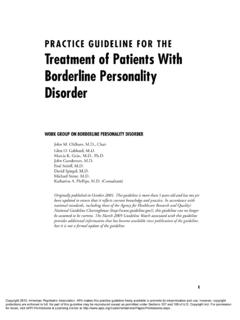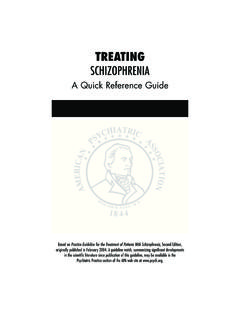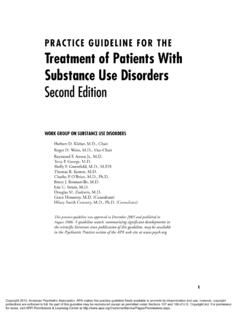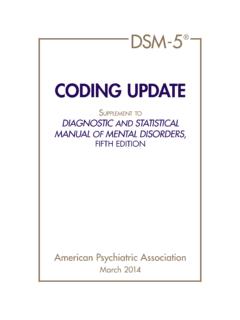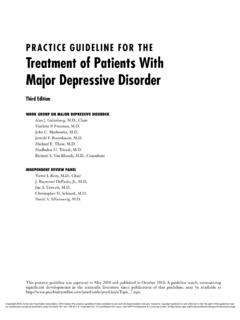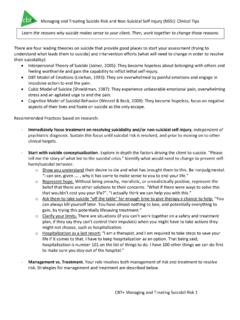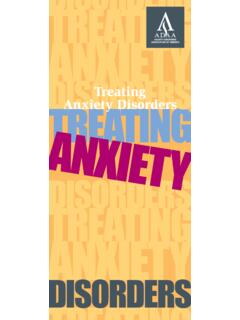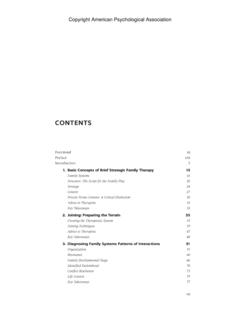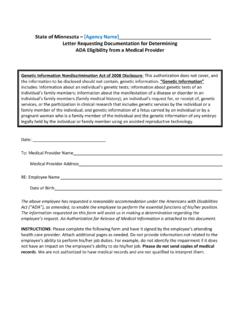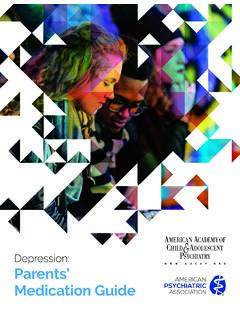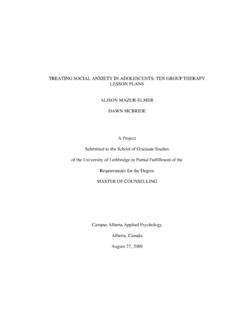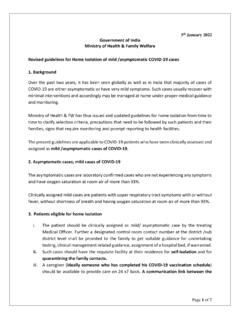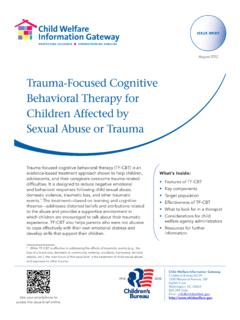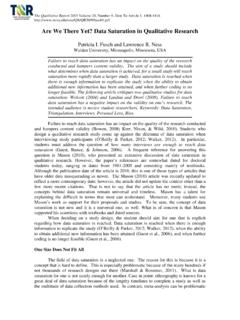Transcription of Treating Major Depressive Disorder - Psychiatry
1 1 Treating Major Depressive DisorderA Quick Reference GuideBased on Practice Guideline for the Treatment of Patients With MajorDepressive Disorder , Third Edition, originally published in October2010. A guideline watch, summarizing significant developments inthe scientific literature since publication of this guideline, may Treating Major Depressive DisorderINTRODUCTIONT reating Major Depressive Disorder : A Quick Reference Guide is asynopsis of the American Psychiatric Association s Practice Guidelinefor the Treatment of Patients With Major Depressive Disorder , ThirdEdition, Part A of which was originally published in The American Jour-nal of Psychiatry in October 2010 and is available through AmericanPsychiatric Publishing, Inc. The psychiatrist using this Quick Refer-ence Guide (QRG) should be familiar with the full-text practice guide-line on which it is based. The QRG is not designed to stand on its ownand should be used in conjunction with the full-text practice guide-line.
2 For clarification of a recommendation or for a review of the ev-idence supporting a particular strategy, the psychiatrist will find ithelpful to return to the full-text practice guideline. STATEMENT OF INTENTThe Practice Guidelines and the Quick Reference Guides are not in-tended to be construed or to serve as a standard of medical of medical care are determined on the basis of all clinicaldata available for an individual patient and are subject to change asscientific knowledge and technology advance and practice patternsevolve. These parameters of practice should be considered guide-lines only. Adherence to them will not ensure a successful outcomefor every individual, nor should they be construed as including allproper methods of care or excluding other acceptable methods ofcare aimed at the same results. The ultimate judgment regarding aparticular clinical procedure or treatment plan must be made by thepsychiatrist in light of the clinical data presented by the patient andthe diagnostic and treatment options available.
3 The development ofthe APA Practice Guidelines and Quick Reference Guides has notbeen financially supported by any commercial Major Depressive Disorder 3A. PSYCHIATRIC MANAGEMENTP sychiatric management consists of interventions and activities thatshould be initiated and provided during all phases of and maintain a therapeutic alliance. Collaborate with the patient in decision making and attend tothe patient s preferences and concerns about treatment. Be aware of transference and countertransference issues. Depressive symptoms may make it harder to develop an the psychiatric general principles and components of a psychiatric evaluation,refer to the American Psychiatric Association s Practice Guideline forthe Psychiatric Evaluation of Adults. A complete diagnosis of depres-sion should address the following: History of the present illness and current symptoms Psychiatric history, including symptoms of mania, current andpast treatments (including duration and dosages), and re-sponses to treatment General medical history Medications, including prescribed and over-the-counter agentsand supplements History of substance use and treatment for substance usedisorders Personal history ( , psychological development, responseto life transitions, Major life events) Social, occupational, and family histories 4 Treating Major Depressive Disorder Review of the patient s prescribed and over-the-counter med-ications Review of systems Mental status examination Physical examination (by psychiatrist or by other health careprofessional)
4 Diagnostic tests as indicated to rule out general medicalcauses of Depressive symptomsEvaluate the safety of the patient. Assessment of suicide risk is essential (Table 1). Note, how-ever, that the ability to predict attempted or completed suicideis poor. If the patient demonstrates suicidal or homicidal ideation, in-tention, or plans, close monitoring is required. Hospitalization should be considered if risk is significant. TABLE TO CONSIDER IN ASSESSING SUICIDE RISKP resence of suicidal or homicidal ideation, intent, or plans History and seriousness of previous attempts Access to means for suicide and the lethality of those means Presence of severe anxiety, panic attacks, agitation, and/or impulsivityPresence of psychotic symptoms, such as command hallucinations or poor reality testing Presence of alcohol or other substance use family history of or recent exposure to suicide Absence of protective factorsTreating Major Depressive Disorder 5 Establish the appropriate treatment setting.
5 Determine the least restrictive setting that will be most likelyto address safety and promote improvement in the patient scondition. Consider the patient s clinical condition, including symptom severity, co-occurringpsychiatric or general medical conditions, and level of func-tioning; available support systems; and ability to adequately care for self , provide reliable feed-back to the psychiatrist, and cooperate with treatment. Reevaluate optimal setting on an ongoing basis. Consider hospitalization if the patient poses serious threat of harm to self or others (involuntaryhospitalization may be necessary if patient refuses); is severely ill and lacks adequate social supports (alterna-tively, intensive day treatment may be appropriate); has certain co-occurring psychiatric or general medical con-ditions; or has not responded adequately to outpatient and address functional impairments and quality of life.
6 Identify impairments in domains such as work, school, family ,social relationships, leisure activities, and maintenance ofhealth and hygiene. Provide interventions to maximize the patient s level of func-tioning and quality of Treating Major Depressive Disorder Help the patient to set goals appropriate to his or her level offunctioning and symptom severity. Coordinate the patient s care with other clinicians involved in the patient s care should have sufficient on-going contact with the patient and with one another to ensure thatcare is coordinated, relevant information is available to guide treat-ment decisions, and treatments are the patient s psychiatric status. Carefully monitor the patient s response to treatment, including symptomatic status, including functional status and qualityof life; degree of danger to self and others; signs of switch to mania; other mental disorders , including alcohol and other sub-stance use disorders ; general medical conditions; side effects of treatment; and adherence to treatment plan.
7 If symptoms change significantly or if new symptoms emerge,consider diagnostic reevaluation. Often family members or caregivers notice changes in the statusof the patient first and are therefore able to provide valuable measurements into psychiatric management. Match the treatment plan to the needs of the patient by systemat-ically assessing symptoms of the illness and effects of Major Depressive Disorder 7 Consider facilitating this matching by integrating clinician- and/orpatient-administered rating scale measurements into initialand ongoing evaluation. (The full guideline provides more dis-cussion of available scales.)Enhance treatment adherence. Assess potential barriers to treatment adherence for example,lack of motivation or excessive pessimism due to depression;side effects of treatment; problems in the therapeutic relation-ship; and logistical, economic, or cultural barriers to treatment.
8 Collaborate with the patient (and, if possible, the family ) to min-imize barriers. Encourage the patient to articulate concerns about treatmentor its side effects, and consider the patient s preferences whendeveloping or modifying the treatment plan. Recognize that during the acute phase, depressed patientsmay be poorly motivated and unduly pessimistic and may suf-fer deficits of memory. During the maintenance phase, euthy-mic patients may undervalue the benefits and focus on theburdens of education to the patient and, when appropriate, to the family . Use language that is readibly understandable to the patient. Clarify common misperceptions about the illness ( , depres-sion is not a real illness) and about treatment ( , antidepres-sants are addictive). Educate about the need for a full course of treatment, the riskof relapse, early recognition of recurrent symptoms, and theimportance of obtaining treatment Treating Major Depressive Disorder Emphasize when and how often to take medication; the typical 2- to 4-week lag for beneficial effects to be no-ticed; the need to continue medication even after feeling better; the need to consult with the prescribing doctor before medi-cation discontinuation; what to do if problems arise; and the need to taper antidepressants when discontinuing them.
9 Promote healthy behaviors such as exercise, good sleep hy-giene, good nutrition, and decreased use of tobacco, alcohol,and other potentially deleterious ACUTE PHASE TREATMENTC hoose an initial treatment. Aim to induce remission of the Major Depressive episode andachieve a full return to the patient s baseline level of function-ing. Remission is defined as at least 3 weeks of the absenceof both sad mood and reduced interest and no more thanthree remaining symptoms of the Major Depressive episode. When selecting an initial treatment modality, consider the fol-lowing: Severity of symptoms Presence of co-occurring disorders or psychosocial stressors Biological, psychological, and environmental factors con-tributing to the current episode of depression Patient preference Prior treatment experiencesTreating Major Depressive Disorder 9 Integrate treatment with psychiatric management and anyother treatments provided for other co-occurring psychiatricdisorders and general medical Modalities Figure 1 describes recommended modalities according to thepatient s severity of illness.
10 Clinical features that may suggest that medications are thepreferred treatment include the following:ModalitySeverity of IllnessPharmaco-therapyDepression-Focuse d Psycho-therapyPharmacotherapy in Combination With Depression-Focused PsychotherapyECTMild to ModerateYe sYe sMay be useful for patients with psy-chosocial or inter-personal problems, intrapsychic conflict, or co-occurring Axis II disorderYe s , f o rcertain patientsSevere Without Psychotic FeaturesYe sN oYe sYe sSevere With Psychotic FeaturesYes, provide both anti-depressant and anti-psychotic medicationNoYes, provide both antidepressant and antipsychotic medicationYe sFIGURE 1 Modalities for Acute Phase Treatment of Major Depressive Disorder 10 Treating Major Depressive Disorder Prior positive response to an antidepressant Moderate to severe symptomatology Significant sleep or appetite disturbances or agitation Anticipation of need for maintenance therapy Patient preference Clinical features that may suggest the use of a depression-focused psychotherapy include the following.




